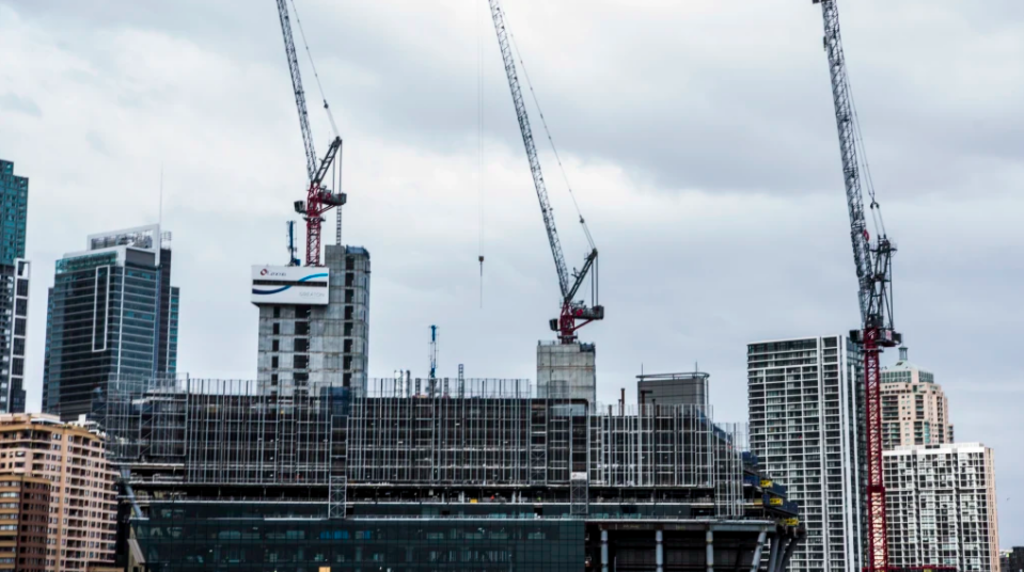
National crane tally falls to two-year low
Crane numbers have fallen 7 per cent across Australia’s two largest cities, prompting warnings that any COVID-19 shutdown of construction sites would delay the start of new projects and send the total tumbling further.
The overall numbers have fallen as the high-rise home-building boom slows and new commercial projects have not kicked in to replace completed ones.
Sydney’s tally fell by 20 cranes to a three-and-a half-year low of 299, while Melbourne’s fell 17 cranes to 196, the lowest in a year and a half, offsetting smaller gains in Brisbane, Canberra, the Gold Coast, Newcastle and Perth. This pulled the national total down to 722 cranes – the lowest in two years – from 757 six months earlier, consultancy RLB’s Q1 2020 crane index showed.
The headline numbers mask the underlying turnover as cranes come down on completed projects and are replaced by new ones starting up. Since RLB’s last count in September, 243 residential cranes have come down across the country’s skylines and 206 new ones have gone up, cutting the total to 484 from 521.
One risk of the COVID-19 pandemic is that investors freeze decisions on new projects and the churn of cranes – and the activity that represents – hits a wall. With private residential projects already on the decline, it is crucial that the pipeline of public and institutional work continues, said Joe Barr, the chief executive of developer and builder John Holland.
“It’s more crucial than ever,” Mr Barr told The Australian Financial Review after visiting the 15-level office project John Holland is developing at 275 George Street in Sydney.
“Because you’ve got the workload that is there and able to be done – major projects and relatively minor projects, rail projects and so on. It’s really important for the economy and the supply chain as well.”
But the fallout of the health and economic crisis – which prompted the federal government to delay the scheduled May budget until October – puts much up in the air.
“There is a fairly large pipeline of hospitals, prisons and other institutional projects – education is another – which are ready to go,” said Richard Frisina a joint managing director of Melbourne-based builder Kane Constructions.
“Whether those funds are diverted to deal with COVID, we’re not sure. We don’t have visibility.”
Construction, a large employer, is not immune to the highly infectious virus – as Kane found out last month after an on-site subcontractor worker tested positive for it – and the industry has stepped up precautions to allow work to continue while minimising the risks.
“There are a whole heap more management processes that are going into controlling social distancing on site, staggering lunch breaks and ensuring hygiene is practised,” Mr Frisina said.
“The workforce is getting the message.”
The slowdown already underway shows the need for the industry to reassure policymakers and the wider public that it can function while taking the necessary precautions.
Sydney’s total as a decline in commercial project cranes hastened the fall from the late 2017 peak of 350.
In Melbourne, the decline was overwhelmingly due to a slump in residential cranes, which fell to 122 from 149, more than offsetting higher numbers of cranes on health, hotel and retail construction projects.
Adelaide’s crane count fell by four to 15, Brisbane rose by one to 58 and Canberra gained two to 27. Cranes on the NSW central coast fell five to nine, while Newcastle gained five to 17; Darwin was unchanged at one and Sunshine Coast unchanged at 11. Gold Coast’s crane total rose by four to 33, Perth rose by three to 37 and Wollongong fell by three to 15. Hobart slipped by one to four.
As residential work has slowed, the non-residential sector has gained in importance. The RLB report showed there were a record 238 non-residential cranes across the country in the commercial, education, health and infrastructure sectors.











